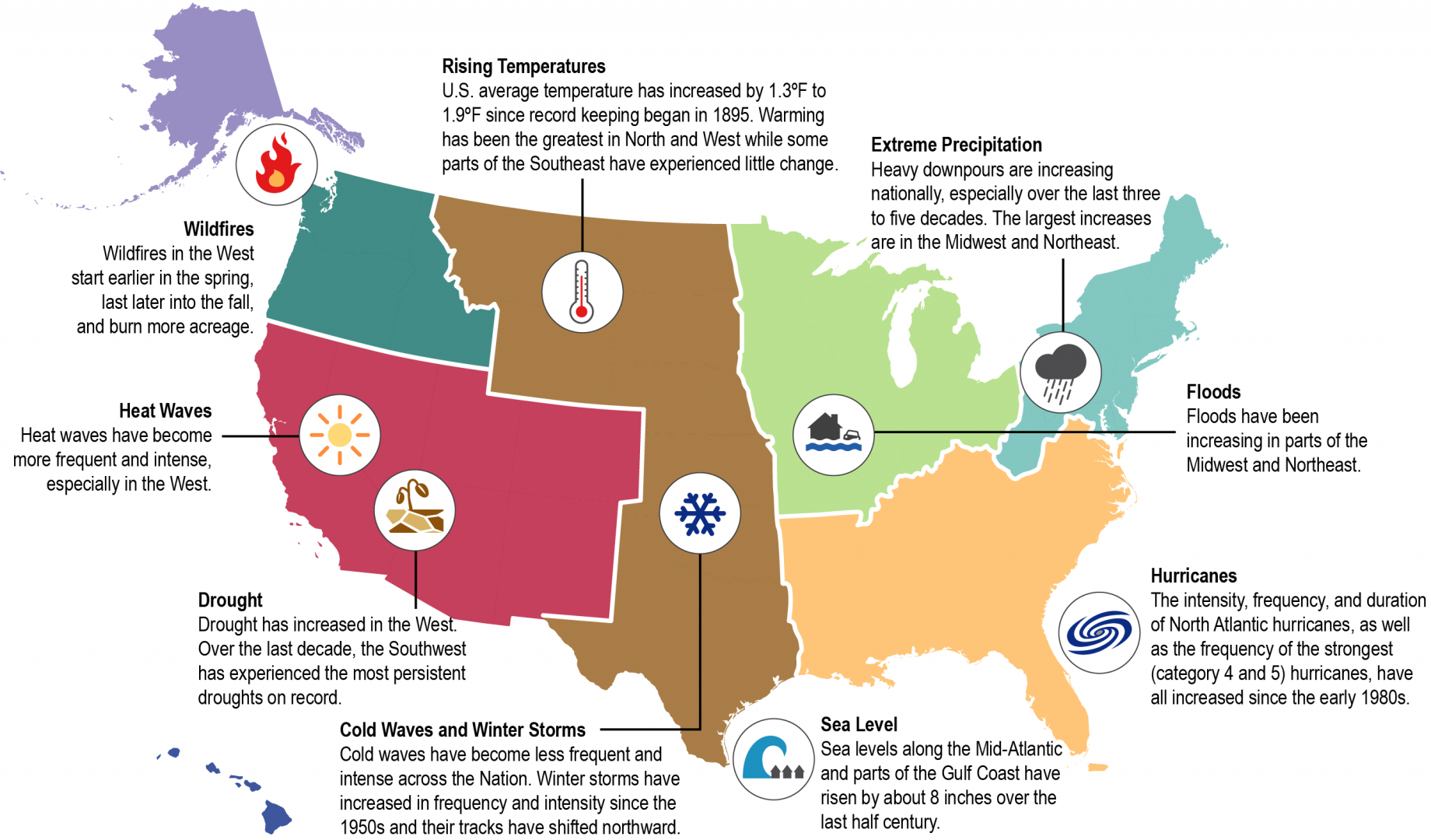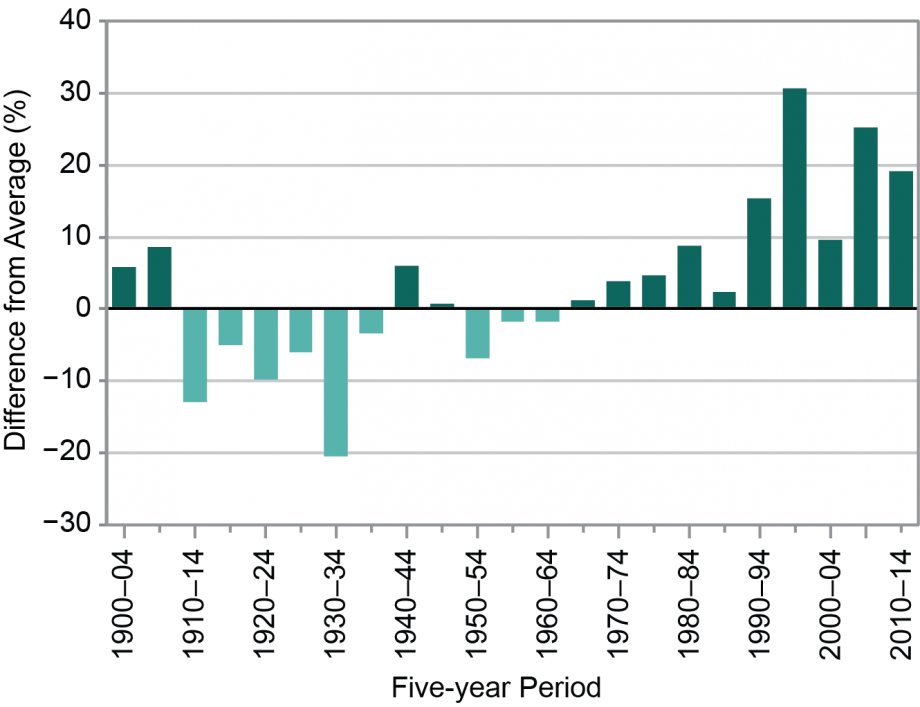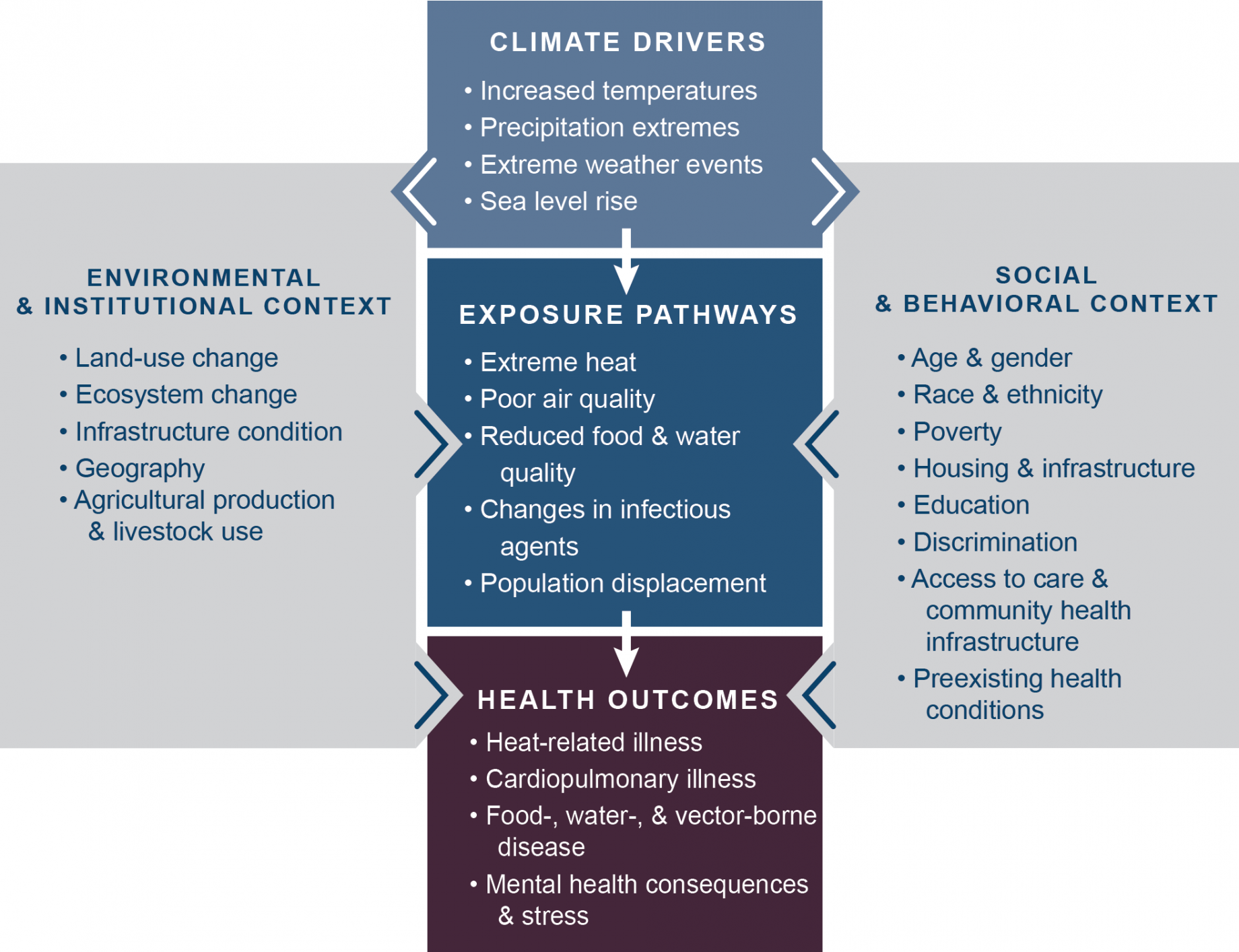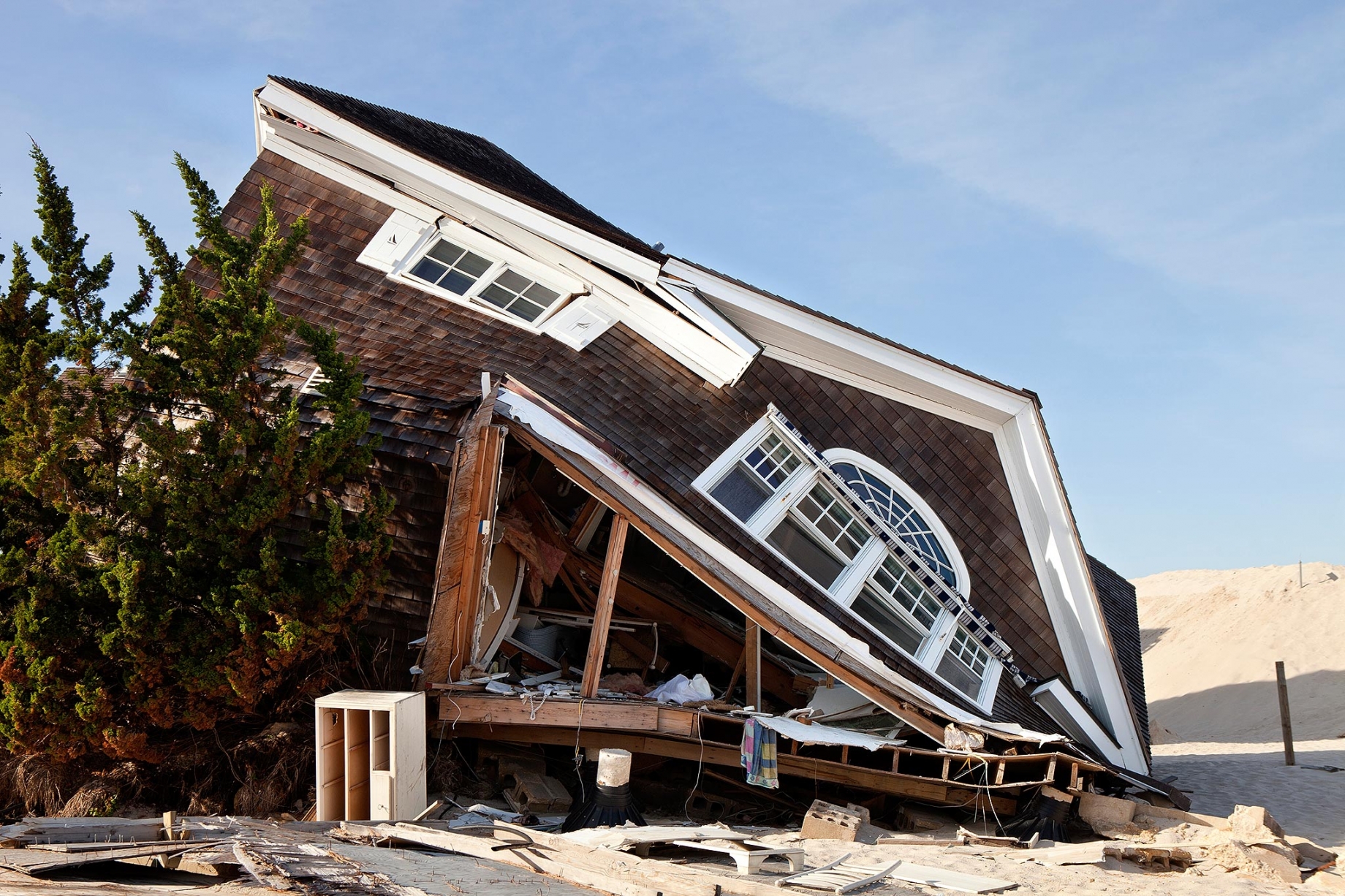Which Human Activity Has Had The Greatest Impact On Climate Change?
Climatic change and Human Wellness
Introduction
- John Balbus
National Institutes of Health - Allison R. Crimmins
U.S. Environmental Protection Agency - Janet L. Gamble
U.S. Ecology Protection Agency
- David R. Easterling
National Oceanic and Atmospheric Administration - Kenneth Due east. Kunkel
Cooperative Institute for Climate and Satellites - NC - Shubhayu Saha
Centers for Affliction Control and Prevention - Marcus C. Sarofim
U.Southward. Ecology Protection Bureau
Man
Given that the impacts of climatic change are projected to increase over the next century, certain existing health threats volition intensify and new health threats may sally. Connecting our understanding of how climate is irresolute with an understanding of how those changes may affect human wellness can inform decisions about mitigating (reducing) the corporeality of futurity climate change, suggest priorities for protecting public health, and help place enquiry needs.
1.ane Our Changing Climate
Observed Climate Change
The fact that the Earth has warmed over the last century is unequivocal. Multiple observations of air and ocean temperatures, sea level, and snowfall and ice have shown these changes to exist unprecedented over decades to millennia. Human influence has been the dominant cause of this observed warming.ane The 2014 U.S. National Climate Cess (2014
The concepts of climate and weather are ofttimes dislocated. Conditionsis the state of the atmosphere at any given time and identify. Conditions patterns vary greatly from year to year and from region to region. Familiar aspects of weather include temperature, precipitation, clouds, and wind that people experience throughout the course of a day. Severe weather weather condition include hurricanes, tornadoes, blizzards, and droughts. Climateis the average weather atmospheric condition that persist over multiple decades or longer. While the weather tin can change in minutes or hours, identifying a change in climate has required observations over a time period of decades to centuries or longer. Climate change encompasses both increases and decreases in temperature as well as shifts in precipitation, changing risks of certain types of astringent atmospheric condition events, and changes to other features of the climate system.
Effigy one.1: Major U.Due south. Climate Trends

Major U.Southward. national and regional
trends. Shaded areas are the U.S. regions defined in the 2014
.2 , iv
Observed changes in climate and weather differ at local and regional scales (Figure i.1). Some climate and weather changes already observed in the United states of america include:2 , 3
Figure 1.ii: Change in Number of Extreme Atmospheric precipitation Events

VIEW
Fourth dimension serial of v-twelvemonth averages of the number of extreme 2-day duration precipitation events, averaged over the United States from 1900 to 2014. The number is expressed as the percent departure from the average for the entire period. This is based on 726 stations that have atmospheric precipitation data for at least 90% of the days in the period. An consequence is considered extreme if the precipitation amount exceeds a threshold for a once-per-year recurrence. (Figure source: adapted from Mellilo et al. 2014)2
- U.Due south. average temperature has increased past one.3°F to one.9°F since recordkeeping began in 1895; nigh of this increment has occurred since near 1970. The beginning decade of the 2000s (2000–2009) was the warmest on record throughout the United States.
- Average U.S. atmospheric precipitation has increased since 1900, just some areas take experienced increases greater than the national average, and some areas have experienced decreases.
- Heavy downpours are increasing nationally, specially over the final iii to five decades. The largest increases are in the Midwest and Northeast, where floods have also been increasing. Figure 1.ii shows how the almanac number of heavy downpours, divers as extreme ii-day precipitation events, for the face-to-face United States has increased, specially betwixt the 1950s and the 2000s.
-
Drought has increased in the Westward. Over the last decade, the Southwest has experienced the most persistent droughts since record keeping began in 1895.4 Changes in precipitation and runoff, combined with changes in consumption and withdrawal, have reduced surface and groundwater supplies in many areas. - There have been changes in some other types of extreme weather condition events over the terminal several decades. Oestrus waves have go more frequent and intense, especially in the West. Cold waves have become less frequent and intense across the nation.
- The intensity, frequency, and duration of North Atlantic hurricanes, too as the frequency of the strongest (category 4 and 5) hurricanes, have all increased since the early 1980s. The relative contributions of human and natural causes to these increases remain uncertain.
Projected Climate Change
Projections of future climate atmospheric condition are based on results from climate models—sophisticated calculator programs that simulate the beliefs of the Earth's climate system. These climate models are used to project how the climate organization is expected to change under dissimilar possible scenarios. These scenarios describe future changes in atmospheric greenhouse gas concentrations,
Figure one.3: Projected Changes in Temperature and Atmospheric precipitation past Mid-Century
Interact with the Figure Beneath
Projected changes in annual average temperature (left) and atmospheric precipitation (right) for 2021–2050 and 2041–2070 with respect to the average for 1971–2000 for the RCP6.0
. The RCP6.0 pathway projects an average global temperature increase of v.ii°F in 2100 over the 1901–1960 global boilerplate temperature (the RCPs are described in more than detail in Appendix 1: Technical Support Document). Temperature increases in the United States for this scenario are in the 2°F to 3°F range for 2021 to 2050 and ii°F to 4°F for 2041 to 2070. This means that the increase in temperature projected in the United States over the next l years under this scenario would exist larger than the i°F to two°F increment in temperature that has already been observed over the previous century. Atmospheric precipitation is projected to subtract in the Southwest and increment in the Northeast. These projected changes are statistically significant (95% confidence) in small-scale portions of the Northeast, every bit indicated by the hatching. (Effigy source: adapted from Sunday et al. 2015) seven
Some of the projected changes in climate in the United States equally described in the 2014 NCA are listed below:2 , iii
- Temperatures in the Us are expected to continue to ascension. This temperature rise has not been, and volition non be, uniform across the country or over time (Effigy 1.iii).
- Increases are too projected for extreme temperature conditions. The temperature of both the hottest 24-hour interval and coldest night of the yr are projected to increase (Figure 1.4).
- More winter and spring precipitation is projected for the northern U.s.a., and less for the Southwest, over this century (Effigy i.3).
- Increases in the frequency and intensity of extreme precipitation events are projected for all U.Southward. areas (Figure 1.iv).
- Brusque-term (seasonal or shorter) droughts are expected to intensify in most U.S. regions. Longer-term droughts are expected to intensify in big areas of the Southwest, the southern Great Plains, and the Southeast. Trends in reduced surface and groundwater supplies in many areas are expected to continue, increasing the likelihood of water shortages for many uses.
- Heat waves are projected to get more than intense, and cold waves less intense, everywhere in the United states.
- Hurricane-associated storm intensity and rainfall rates are projected to increase equally the climate continues to warm.
Figure 1.iv: Projected Changes in the Hottest/Coldest and Wettest/Driest Day of the Year
Collaborate with the Figure Below
Projected changes in several
variables for 2046–2065 with respect to the 1981–2000 average for the RCP6.0
. These include the coldest night of the year and the hottest mean solar day of the twelvemonth. By the centre of this century, the coldest dark of the year is projected to warm by 6°F to 10°F over most of the country, with slightly smaller changes in the south. The warmest 24-hour interval of the yr is projected to exist 4°F to 6°F warmer in about areas. Besides shown above are projections of the wettest day of the yr and the annual longest sequent dry day spell. Extreme atmospheric precipitation is projected to increment, with an average change of v% to 15% in the precipitation falling on the wettest day of the twelvemonth. The length of the annual longest dry spell is projected to increase in almost areas, but these changes are small: less than ii days in about areas. (Effigy source: adapted from Sun et al. 2015)7
1.2 How Does Climate change Touch on Wellness?
The influences of
A useful approach to understand how climate change affects health is to consider specific
Whether or not a person is exposed to a health threat or suffers illness or other adverse health outcomes from that exposure depends on a complex fix of
- Exposure is contact between a person and one or more biological, psychosocial, chemic, or physical stressors, including stressors affected past climate change. Contact may occur in a unmarried instance or repeatedly over time, and may occur in one location or over a wider geographic surface area.
- Sensitivity is the degree to which people or communities are affected, either adversely or beneficially, by
climate variability or change. -
Adaptive capacity is the ability of communities, institutions, or people to adjust to potential hazards, to take advantage of opportunities, or to respond to consequences. A related term, resilience, is the power to prepare and plan for, absorb, recover from, and more successfully adapt to adverse events.
(definitions adjusted from
Vulnerability, and the three components of vulnerability, are factors that operate at multiple levels, from the individual and customs to the country level, and touch on all people to some degree.nine For an private, these factors include homo behavioral choices and the degree to which that person is vulnerable based on his or her level of exposure, sensitivity, and adaptive chapters. Vulnerability is also influenced by
At a larger community or societal calibration, health outcomes are strongly influenced past adaptive capacity factors, including those related to the natural and built environments (for instance, the country of
The three components of vulnerability (exposure, sensitivity, and adaptive capacity) are associated with social and
Effigy one.5: Climate Change and Health

Conceptual diagram illustrating the
pathways past which
affects human
. Exposure pathways exist within the context of other factors that positively or negatively influence wellness outcomes (grayness side boxes). Cardinal factors that influence
for individuals are shown in the right box, and include
and behavioral choices. Cardinal factors that influence vulnerability at larger scales, such equally natural and built environments, governance and management, and institutions, are shown in the left box. All of these influencing factors can affect an individual'south or a community's vulnerability through changes in exposure,
, and
and may also exist affected by climate change.
We are already experiencing changes in the frequency, severity, and even the location of some weather condition and climate phenomena, including extreme temperatures, heavy rains and droughts, and some other kinds of severe weather, and these changes are projected to continue. This means that areas already experiencing health-threatening weather condition and climate phenomena, such as severe oestrus or hurricanes, are likely to experience worsening impacts, such every bit even college temperatures and increased storm intensity, rainfall rates, and
Climate change can therefore affect human health in two chief ways: first, by changing the severity or frequency of health bug that are already afflicted by climate or weather factors; and 2nd, by creating unprecedented or unanticipated health problems or wellness threats in places where they take non previously occurred.
i.3 Our Changing Health
In order to empathize how
Demographic and Socioeconomic Trends
The Usa is in the midst of several pregnant demographic changes: the population is aging, growing in number, becoming more ethnically diverse, and demonstrating greater disparities between the wealthy and the poor. Immigration is having a major influence on both the size and age distribution of the population.15 Each of these demographic trends has implications for climatic change related human health impacts (see Ch. 9: Populations of Business organization). Some of these trends and projections are summarized below:
Trends in population growth
- The total U.Southward. population has more than doubled since 1950, from 151,325,798 persons in 1950 to 308,745,538 in 2010.16
- The Demography Bureau projects that the U.S. population will grow to almost 400 meg by 2050 (from estimates of nearly 320 one thousand thousand in 2014).17
Trends in the elderly population
- The nation'southward older adult population (ages 65 and older) volition most double in number from 2015 through 2050, from approximately 48 million to 88 million.18 Of those 88 million older adults, a little nether nineteen 1000000 volition exist 85 years of age and older.nineteen
Trends in racial and ethnic diversity
- As the United states becomes more diverse, the amass minority population is projected to get the majority by 2042.18 The non-Hispanic or non-Latino White population will increase, only more slowly than other racial groups. Non-Hispanic Whites are projected to go a minority by 2050.20
- Projections for 2050 suggest that nearly xix% of the population volition be immigrants, compared with 12% in 2005.20
- The Hispanic population is projected to almost double from 12.5% of the U.S. population in 2000 to 24.half dozen% in 2050.21
Trends in economic disparity
- Income inequality rose so stabilized during the last 30 years, and is projected to resume ascent over the next 20 years, though at a somewhat slower overall rate that declines to most zero by 2035.22 For example, the Gini coefficient, a measure out of income inequality, is estimated to have risen by 18% betwixt 1984 and 2000, and is projected to rising by an boosted 17% for all workers between 2009 and 2035.22
- America's communities of color have disproportionately college poverty rates and lower income levels. While racial disparities in household wealth were higher in the late 1980s than now, trends in more recent years have been toward greater inequality. The ratio of the median net household worth of White, not-Hispanic versus non-White or Hispanic households increased from six.0 to 7.eight between 2007 and 2013.23 In 2009, 25.8% of non-Hispanic Blacks and 25.3% of Hispanics had incomes below the poverty level equally compared to ix.4% of non-Hispanic Whites and 12.v% of Asian Americans.24 In 2014, the median income level for a non-Hispanic Black household was approximately $35,000, $25,000 lower than a non-Hispanic White household.25
Population growth and migration in the Usa may place more people at
Trends in Wellness Status

Tempest-damaged home afterwards Hurricane Sandy © iStockPhoto. com/Aneese
Every bit a nation, trends in the population's wellness are mixed. Some major indicators of health, such equally life expectancy, are consistently improving, while others, such every bit charge per unit and number of
Climate change impacts to man health will act on summit of these underlying trends. Some of these underlying health conditions tin increase
Examples of health indicators that have been improving betwixt 2000 and 2013 include the following:
- Life expectancy at nativity increased from 76.viii to 78.8 years.xxx
- Death rates per 100,000 people from heart disease and cancer decreased from 257.half dozen to 169.8 and from 199.6 to 163.2, respectively.30
- The percent of people over age 18 who say they smoke decreased from 23.ii% to 17.8%.thirty

© Monkey Business Images/Corbis
At the same time, some health trends related to the prevalence of
- The percentage of adult (18 years and older) Americans describing their wellness as "poor or fair" increased from 8.ix% in 2000 to 10.3% in 2012.30
- Prevalence of doctor-diagnosed diabetes among adults aged 20 and over increased from 5.two% in 1988-1994 to 8.4% in 2009-2012.xxx
- The prevalence of obesity amidst adults (anile 20–74) increased by almost 3-fold from 1960–1962 (13.4% of adults classified as obese) to 2009–2010 (36.one% of adults classified as obese).31
- In the past 30 years, obesity has more than doubled in children and quadrupled in adolescents in the United States. The percentage of children anile six–11 who were obese increased from 7% in 1980 to near xviii% in 2012. Similarly, the percentage of adolescents aged 12–19 years who were obese increased from 5% to nearly 21% over the same flow. In 2012, approximately one-third of American children and adolescents were overweight or obese.32
Table ane.1 shows some examples of underlying wellness conditions that are associated with increased vulnerability to health effects from climate alter related exposures (come across Ch. nine: Populations of Business for more details) and provides information on electric current condition and future trends.
Wellness status is often associated with demographics and socioeconomic status. Changes in the overall size of the population, racial and ethnic composition, and age distribution affect the health condition of the population. Poverty, educational attainment, access to care, and bigotry all contribute to disparities in the incidence and prevalence of a variety of medical weather condition (see Ch. ix: Populations of Concern). Some examples of these interactions include:
Older Adults. In 2013, the percentage of adults age 75 and older described equally persons in fair or poor wellness totaled 27.vi%, as compared to six.ii% for adults historic period 18 to 44.30Among adults age 65 and older, the number in nursing homes or other residential care facilities totaled one.eight meg in 2012, with more than one one thousand thousand utilizing home health intendance.33

© Stephen Welstead/LWA/ Corbis
Children. Approximately 9.0% of children in the United States have asthma. Between 2011 and 2013, rates for Blackness (xv.3%) and Hispanic (8.half-dozen%) children were college than the rate for White (vii.eight%) children.30 Rates of asthma were also higher in poor children who live beneath 100% of the poverty level (12.4%).30
Non-Hispanic Blacks. In 2014, the per centum of non-Hispanic Blacks of all ages who were described every bit persons in fair or poor health totaled xiv.3% equally compared to 8.7% for Whites. Wellness gamble factors for this population include high rates of smoking, obesity, and
Hispanics. The percentage of Hispanics of all ages who were described as persons in fair or poor health totaled 12.7% in 2014. Health disparities for Hispanics include moderately college rates of smoking in adults, low nativity weights, and infant deaths.thirty
The impacts of climate modify may worsen these health disparities by exacerbating some of the underlying conditions they create. For example, disparities in life expectancy may be exacerbated past the effects of climatic change related heat and air pollution on minority populations that have college rates of hypertension, smoking, and diabetes. Conversely, public health measures that reduce disparities and overall rates of disease in populations would lessen vulnerability to worsening of wellness status from climate change effects.
Table one.1: Current estimates and time to come trends in chronic health conditions that interact with the health risks associated with climatic change
Click on a table row for more than information.
| | Current Estimates | Future Trends | Possible Influences of |
|---|---|---|---|
| ALZHEIMER'S Disease | Approximately 5 million Americans over 65 had Alzheimer's disease in 2013.34 | | Persons with |
| | Average asthma prevalence in the U.S. was higher in children (ix% in 2014)30 than in adults (7% in 2013).35 Since the 1980s, asthma prevalence increased, simply rates of asthma deaths and infirmary admissions declined.36 , 37 | Stable | Asthma is exacerbated past changes in pollen flavour and allergenicity and in exposures to air pollutants affected by changes in temperature, humidity, and current of air.29 |
| | In 2012, approximately half dozen.3% of adults had COPD. Deaths from chronic lung diseases increased by 50% from 1980 to 2010.38 , 39 | Chronic | COPD patients are more than sensitive than the full general population to changes in ambient air quality associated with climate change. |
| | In 2012, approximately 9% of the total U.S. population had diabetes. Approximately 18,400 people younger than age 20 were newly diagnosed with blazon one diabetes in 2008–2009; an additional 5,000 were diagnosed with type two. forty | New diabetes cases are projected to increase from near 8 cases per i,000 in 2008 to well-nigh xv per 1,000 in 2050. If recent increases continue, prevalence is projected to increase to 33% of Americans by 2050. 41 | Diabetes increases |
| | Cardiovascular disease ( | By 2030, approximately 41% of the U.South. population is projected to have some grade of CVD.43 | Cardiovascular illness increases sensitivity to oestrus stress. |
| MENTAL ILLNESS | | By 2050, the total number of U.S. adults with depressive disorder is projected to increment past 35%, from 33.9 million to 45.viii 1000000, with those over age 65 having a 117% increment. 44 | Mental disease may impair responses to |
| | In 2009–2010, approximately 35% of American adults were obese.32 In 2012, approximately 32% of youth (anile 2–xix) were overweight or obese.46 , 47 | By 2030, 51% of the U.S. population is expected to exist obese. Projections suggest a 33% increase in obesity and a 130% increase in severe obesity.48 | Obesity increases sensitivity to high ambient temperatures. |
| | Approximately 18.seven% of the U.S. population has a disability. In 2010, the pct of American adults with a disability was approximately 16.6% for those age 21–64 and 49.viii% for persons 65 and older. 49 | The number of older adults with activity limitations is expected to grow from 22 million in 2005 to 38 meg in 2030.fifty | Persons with disabilities may notice it hard to respond when evacuation is required and when there is no available means of transportation or like shooting fish in a barrel go out from residences. |
one.iv Quantifying Wellness Impacts
For some changes in exposures to

The ability to quantify many types of health impacts is dependent on the availability of data on the baseline
Information on trends in underlying health or background rates of wellness impacts is summarized in Department 1.iii, "Our Changing Health." Data on the incidence and prevalence of health atmospheric condition are obtained through a complicated organisation of state- and city-level
Characterizing certain types of climate change related exposures can be a claiming. Exposures tin consist of temperature changes and other
Modeling Approaches Used in this Report
Four chapters within this assessment—Ch. 2: Temperature-Related Death and Disease, Ch. 3: Air Quality Impacts, Ch. 5: Vector-Borne Diseases, and Ch. half-dozen: H2o-Related Illness—include new peer-reviewed, quantitative analyses based on modeling. The analyses highlighted in these chapters mainly relied on climate model output from the Coupled Model Intercomparison Project Phase 5 (CMIP5). Due to limited data availability and computational resource, the studies highlighted in the four chapters analyzed only a subset of the total CMIP5 dataset, with most of the studies including at least ane analysis based on RCP6.0, an upper midrange greenhouse gas concentration pathway, to facilitate comparisons across chapters. For example, the air quality analysis examined results from two different RCPs, with a unlike climate model used for each, while the waterborne analyses examined results from 21 of the CMIP5 models for a unmarried
Adverse health effects attributed to climate change tin can have many economic and social consequences, including direct medical costs, work loss, increased care giving, and other limitations on everyday activities. Though economic impacts are a crucial component to agreement risk from climate alter, and may have important direct and secondary impacts on human health and well-being by reducing resources available for other preventative health measures, economic valuation of the health impacts was not reported in this assessment.
Dubiety in Health Impact Assessments
Figure 1.vi illustrates dissimilar sources of uncertainty along the exposure pathway.
Effigy 1.6: Sources of Uncertainty

Examples of sources of
in projecting impacts of
on human
. The left column illustrates the
pathway through which climate modify can affect homo health. The right cavalcade lists examples of key sources of uncertainty surrounding effects of climate change at each stage along the exposure pathway.
Two of the key uncertainties in projecting futurity global temperatures are ane) uncertainty about future concentrations of
Uncertainty in electric current and future estimates of wellness or
The factors related to uncertainty in exposure–response functions are like to those for the projections of health or socioeconomic status. Estimates are more uncertain for smaller subpopulations, less-prevalent health conditions, and smaller geographic areas. Considering these estimates are based on observations of existent populations, their validity when applied to populations in the future is more uncertain the farther into the futurity the application occurs. Doubtfulness in the estimates of the exposure–result relationship also comes from factors related to the scientific quality of relevant studies, including appropriateness of methods, source of data, and size of study populations. Expert judgment is used to evaluate the validity of an individual written report also as the collected group of relevant studies in assessing doubt in estimates of exposure–outcome relationships.
Arroyo to Reporting Uncertainty in Key Findings
Despite the sources of dubiety described in a higher place, the current state of the science allows an exam of the probable direction of and trends in the health impacts of climate change. Over the past ten years, the models used for climate and health assessments have become more than useful and more accurate (for instance, Melillo et al. 2014).6 , 53 , 54 This assessment builds on that improved capability. A more detailed discussion of the approaches to addressing doubtfulness from the various sources can be establish in the Guide to the Report and Appendix 1: Technical Support Document.
Ii kinds of language are used when describing the dubiety associated with specific statements in this report: conviction language and likelihood linguistic communication (see beneath). Confidence in the validity of a finding is expressed qualitatively and is based on the type, amount, quality, force, and consistency of evidence and the caste of expert agreement on the finding. Likelihood, or the projected probability of an touch on occurring, is based on quantitative estimates or measures of uncertainty expressed probabilistically (in other words, based on statistical assay of observations or model results, or on skillful judgment). Whether a Cardinal Finding has a confidence level associated with it or, where findings tin exist quantified, both a confidence and likelihood level associated with information technology, involves the adept assessment and consensus of the affiliate author teams.
Likelihood and Confidence Level
Likelihood
| Very Probable ≥nine in ten | Probable ≥2 in 3 | Equally Probable as Not ≈ one in 2 | Unlikely ≤ 1 in 3 | Very Unlikely ≤ane in x |
Confidence Level
Very High Strong show (established theory, multiple sources, consistent results, well documented and accepted methods, etc.), high consensus
High Moderate evidence (several sources, some consistency, methods vary and/or documentation express, etc.), medium consensus
Medium Suggestive testify (a few sources, limited consistency, models incomplete, methods emerging, etc.), competing schools of thought
Depression Inconclusive evidence (express sources, extrapolations, inconsistent findings, poor documentation and/or methods non tested, etc.), disagreement or lack of opinions among experts
References
Source: https://health2016.globalchange.gov/climate-change-and-human-health
Posted by: chavezhond1975.blogspot.com

0 Response to "Which Human Activity Has Had The Greatest Impact On Climate Change?"
Post a Comment